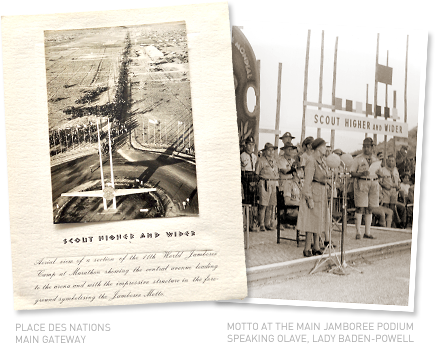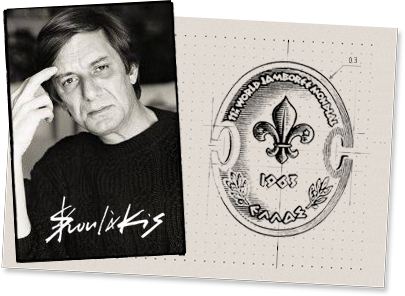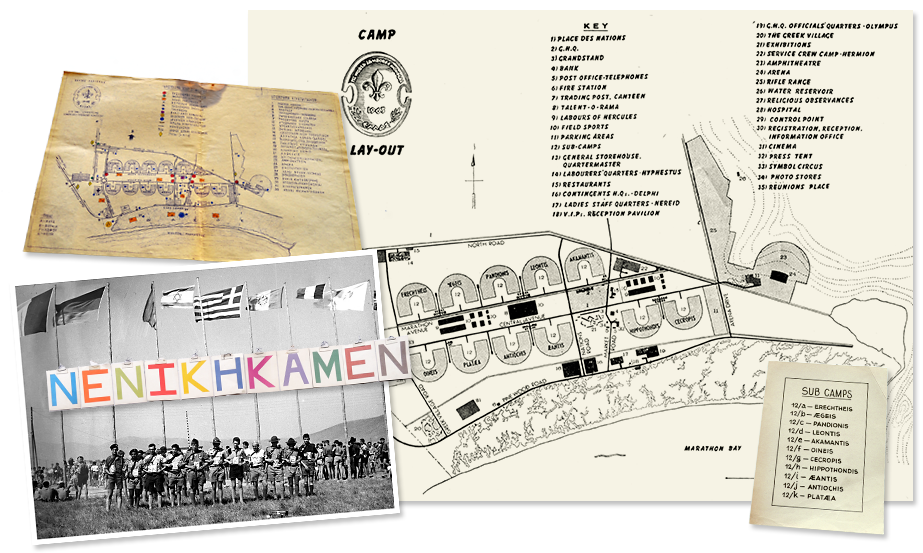
The Jamboree theme, "Scout Higher and Wider", meant to encourage a continuous effort to explore higher and wider not only in 1963's world of scientific and technological progress into outer space, but also to explore the field of higher and wider standards of courage, integrity and honour.
The imposing structure at Place des Nations (Nation's Square), the Jamboree's main gateway, symbolized exactly this motto: Higher and Wider. It was designed by Stavros Michalitsianos.
In ancient times, the Greek shields were originally made of leather, stretched tightly over a frame. At the centre, which was called the navel, the skins overlapped to form a thick place invulnerable to enemy arrows. The warriors of those days therefore had to be very skilful with their shields, using the middle, where they were strongest, rather than the outer edges, to protect themselves.
They used to decorate this centre point with symbols, with the faces of their gods or terrifying monsters to strike fear into the hearts of their opponents. Our fleur-de-lys (very like the acanthus flower motif on the capital of the Corinthian column of Greek temples) is placed at the centre of the badge, not only to decorate it, but also symbolise the strength of our ideals against the evils and dangers of life.
The ring binding the fleur-de-lys is in the very middle of the shield, to show the strength coming from the unity of Boy Scouts throughout the world, working together for the benefit of the whole of mankind. As well as the inscription about the emblem, and the word ΕΛΛΑΣ (Greece) below, there are the two branches of an olive, the sacred tree of Athena, goddess of Athens, and symbol of peace. The five leaves on each branch together represent the ten articles of the Scout Law and the three olives the threefold Promise.
A bronze Jamboree Badge, 37 mm wide x 45 mm tall was issued to every participant and was worn above the right pocket of the scout shirt. The scouts were warned not to exchange or lose their badge as it could not be replaced. Silver patina Jamboree Badges of equal dimensions were worn by the HQ Staff. These two badges, together with the small silver pativa pin, height 25mm, and the Laurel Award (Epathlon Dafnis) could not be bought. Other souvenirs such as wooden base plaques, walking stick badges, bronze pins, key rings, tie pins, cuff-links, silver patina souvenir spoons could be bought in the Scout Shops.

 The person who designed the jamboree emblem was Demosthenes (Dimos) Skoulakis, a Greek painter and visual artist born in Athens in 1939 with family stock from Chania city, Crete. He studied in the prestigious School of Fine Arts of Athens and in Paris, alongside world-famous Greek painters Fotis Kontoglou and Yiannis Moralis. He also studied stage design and initially worked as a cartoonist for newspapers and magazines. The anthropocentric character was characteristic of Skoulakis' work and indicated the clear influences by his teachers.
The person who designed the jamboree emblem was Demosthenes (Dimos) Skoulakis, a Greek painter and visual artist born in Athens in 1939 with family stock from Chania city, Crete. He studied in the prestigious School of Fine Arts of Athens and in Paris, alongside world-famous Greek painters Fotis Kontoglou and Yiannis Moralis. He also studied stage design and initially worked as a cartoonist for newspapers and magazines. The anthropocentric character was characteristic of Skoulakis' work and indicated the clear influences by his teachers.
Skoulakis was a relative of the Chief Executive Commissioner of the Scouts of Greece and jamboree Camp Chief Dimitris "Rann" Alexatos, the person who not only conceived the idea of organizing the 11th jamboree in the country, but also carried it through under many difficulties. Alexatos was scouting mentor to Chief Scout of Greece Crown Prince Constantine and had friendly relations with the Greek Royal Palace. Under the circumstances, the 24 year old Skoulakis who was fulfilling his military duties in 1963, found himself seconded to the military staff working for the jamboree signs, documents and forms.
Dimos Skoulakis passed away on Wednesday, December 10th, 2014 at age 75. Greek scouts will perhaps never see another design of such world recognizability, nor is it likely that Dimos Skoulakis will ever be known for this specific design. Luckily, his legacy as an artist is there for the world to ponder.
This was the actual last word of Phidippides, the ancient Greek soldier-messenger who, in 490 BC, ran all the way from Marathon to Athens, 26 miles 385 yards or 42,195 km, to convey to his fellow Athenians the news of victory against the Persians at the historic Battle of Marathon. He whispered NENIKHKAMEN and fell dead from exhaustion. He was the one to define the route what later became the cornerstone of Olympic sports: The Marathon Race.



© Copyright 2013, marathon1963.com & proskopos.com. All rights reserved.
No part of the material contained in this website (images, texts, artwork) may be used or reproduced without
written permission or invitation by the publisher. Request permission to use or reproduce material.